
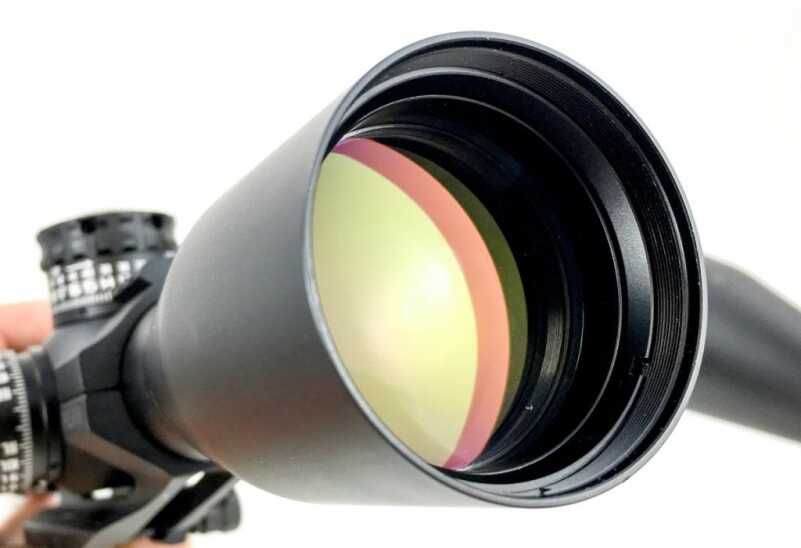
The reticle inside your scope is a lot more important than one might assume. How do you decide which one is right for you?
 What’s the last thing you see before you pull the trigger? The reticle!
What’s the last thing you see before you pull the trigger? The reticle!
THE SERIES
- Part 1: Optics Buying Guide: Iron Sights, Red Dots, and Scopes
- Part 2: Optics Buying Guide: Top Must-Know Terms for Picking the Right Scope
- Part 3: Optics Buying Guide: Scope Mounts
- Part 4: Optics Buying Guide: How To Properly Zero Your Scope
- Part 5: Optics Buying Guide: Finding Your Range with a Scope Reticle
- Part 6: Optics Buying Guide: Hold Off vs. Adjustable Scope Turrets
- Part 7: Optics Buying Guide: Scope Reticles
- Part 8: Optics Buying Guide: Using a Laser Rangefinding Scope
- Part 9: Optics Buying Guide: Holographic and Red Dot Optics
- Part 10: Optics Buying Guide: AR-15 Optics and Scopes
- Part 11: Optics Buying Guide: Big Scopes
- Part 12: Optics Buying Guide: Do You Get What You Pay For?
I’ll bet most of us tend to give only passing thought to reticle selection, but there’s a reason that there are somewhere over 96.2 billion reticle designs floating around out there. They’re designed for specific purposes. For example, a thick, course, reticle might be useful for visibility in lower light and brushy short-range hunting conditions. A reticle with very fine crosshairs will allow you to aim very, very precisely at longer distances. And there are a million other variations for different purposes.
Here, we’re going to take a look at a basic reticle types and help clarify when you would choose one design over another. The primary consideration for choosing an effective reticle is to think about the most common application for that specific optic. In other words, what are you going to do with it? Are you going to hunt in thick woods? Are you going to compete in 3-Gun? Do you want it for a home defense rifle? Are you going to use it for accuracy competition? Just plinking? Or something else entirely? Once you have your most common anticipated use nailed down, the universe of sensible reticles types gets much smaller.
Since there are so many types of reticles, let’s create some categories by general type so we can look at situations where each general style will excel.
Dot Reticles
As the name implies, a dot reticle isn’t very complicated. In fact, it’s just a dot. Most (probably the vast majority) that you’ll find are illuminated regardless of the technology used to put the dot on the glass. The Burris FastFire is a classic example of this type of reticle. With zero magnification and no tube to interfere with the field of view, it offers great overall visibility and fast sighting. You’ll find red dot reticles with different sized dots from two MOA to eight MOA depending on the intended application. A smaller dot will provide more precision at longer ranges at the sacrifice of speed and high visibility at shorter range.
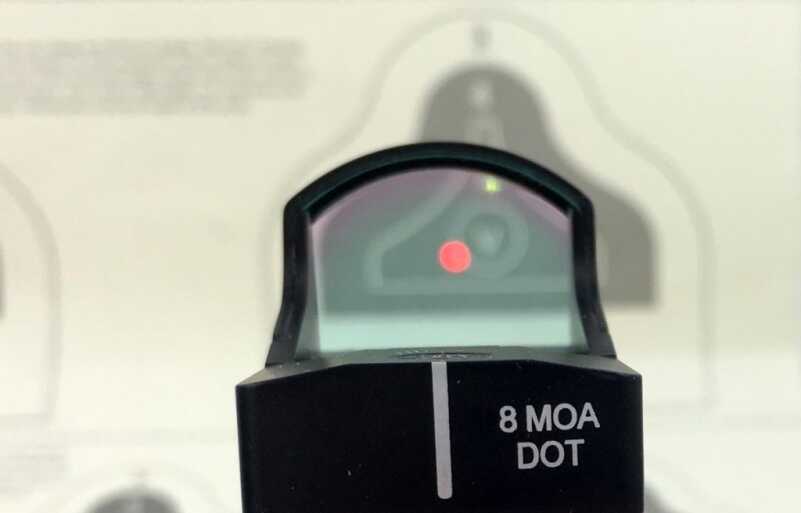
A simple dot reticle like this one on the Burris FastFire 3 is great for pistol or rifle use inside a hundred yards or so.
When to choose: A need for speed, zero or very low magnification, and ranges less than 100 yards are the ideal situations for a simple red dot, although there’s no reason you can’t stretch out to a couple of hundred yards with a small and precise dot.
Duplex Reticles
What’s a “duplex” reticle? If you consider the example we discussed at the beginning of this article, thick reticle bars for visibility and fine ones for precision, a duplex reticle is a combination of both. The outer sections of the crosshairs are thick for visibility and speed, while the inner section is fine for precision. A pure duplex reticle has no other horizontal or vertical hash marks. It’s just a set of crosshairs, although they vary in width.

The thick lines of this Burris Heavy Duplex reticle make it fast and easy to see against busy target backgrounds.
When to choose: Duplex reticles, such as this Burris Heavy Plex, are great for short to moderate range hunting scenarios. As many rifle cartridges shoot “flat” from zero to 200 yards or so, depending on how you zero, there is no need to make significant turret or holdover adjustment to hit a target within that range. In the woods, the thick outer bars of the duplex are easy to pick up. Once you acquire the outline of the reticle, it’s easier to see the finer crosshairs in the middle to establish a precise point of aim. Since there are no range compensation marks, this design is slower to adjust for long range shots as you have to adjust turrets to get the crosshairs right on target.
Ballistic Drop Compensation Reticles
Ballistic Drop Compensation (BDC) reticles are like simple crosshair or duplex reticles, but with one significant addition. Horizontal marks below the center crosshairs establish known adjustment points for holding over on a distant target. For example, if you’re shooting a .308 at a target 400 yards away with a duplex reticle, your going to have to either adjust the turrets or guess at a holdover amount. In case you’re not familiar with the term “holdover,” that simply means placing the center crosshair intersection above the intended target to account for bullet drop over distance. On a simple duplex reticle, there is no reference on the vertical crosshair to tell you exactly how high to hold, so you have to guess.

This Burris Ballistic Plex has lines to designate holdover points of 200, 300, and 400 yards. The top of the bottom post indicates 500 yards.
BDC reticles solve this problem. Like the Burris Ballistic Plex, BDC reticles have marks that correspond to known distances for “average” loads of a given caliber. For example, the Burris Droptine 3-9×40 scope offers a Ballistic Plex reticle option for “standard hunting calibers.” The three lines below the crosshairs correspond to 200, 300, and 400 yards respectively. The top of the lower duplex post indicates the hold point for 500 yards. Of course, you’ll want to verify and tune these measurements with a one-time trip to the range as your specific gun and ammo may vary a bit from average.
When to choose: Since most BDC reticles designs are fairly “coarse” and have just a handful of marks for 100-yard distance increments, they’re good for getting off fast shots at varying distances. If you need extreme precision for elevation, and have time between shots, a scope that has external turrets may be the preferred options.
Mil-Dot and MOA Reticles
Mil-dot and MOA reticles provide a visual system of known measurement marks on the crosshairs themselves. Rather than trying to match marks on the reticle to known distances for the trajectories of specific cartridges, the mil-dot system provides marks of consistent and known distance so you can do your own mapping. You might think of it as a speedometer with no numbers. Rather than rely on an estimate of your speed based on average tire sizes that might be compatible with your car, you would calibrate the marks on the speedometer dial so you know the precise speed at each mark given your specific tire diameter. Similarly, if you know the exact measurements of the reticle marks and the performance of your specific bullet, then you can determine the relationship between each of those marks and range for your cartridge.
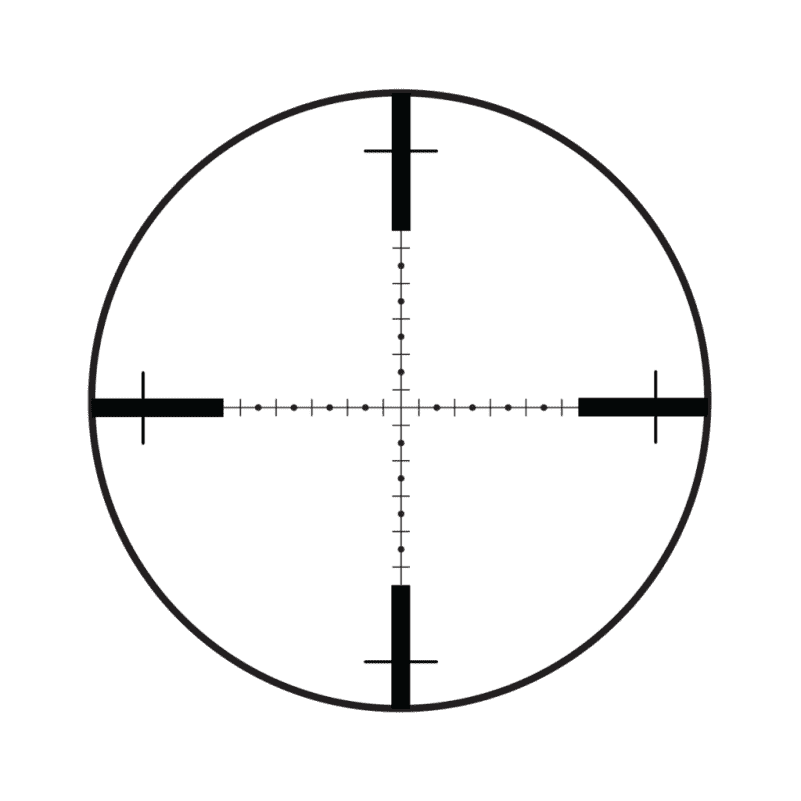
This Burris G2B is a classic example of a mil-dot style reticle.
The neat thing about “generic” mil-dot or minute of angle reticles is that you can also use them in reverse. Those marks can be used to “size objects” by looking at them through your scope. With a little basic math, you can determine how far away your target is. Refer to an earlier article in this series, Optics Buying Guide: Finding Range with a Scope, to see exactly how that works.
When to choose: While you can figure out the range to target with most any reticle with known markings, a mil-dot is designed specifically to do that. Everything on the reticle, including the dots themselves, correspond to a known mil measurement, so it’s easy to get precise with distance estimations. So, if you want this capability, consider a mil-dot or similar minute of angle reticle. The other handy use for these is using with multiple guns, calibers, or even loads within the same caliber. An extreme example would be a scope for use with 300 Blackout. That caliber has a wide range of bullet profile and velocity capability. If you use a mil-dot reticle, you can create a different range card for each 300 Blackout variant you’ll be shooting. For example, one card might tell you the distance for each dot on your reticle when using 220-grain subsonic ammunition. Another card might be tuned for 110-grain supersonic loads. Many calibers have a broad range of bullet weight and velocity combinations, so a “generic” reticle design like this can really be handy.
Wind Drift Reticles
While not mutually exclusive to other reticle designs, meaning some reticles have multiple features, this style emphasizes marks across the horizontal plane to help account for either moving targets or wind drift. On many reticles like these, you’ll notice a Christmas tree type design. That’s because as the distance increases, the holdover (to the side) amount for wind also increases since the bullet is in the air and subject to wind longer.
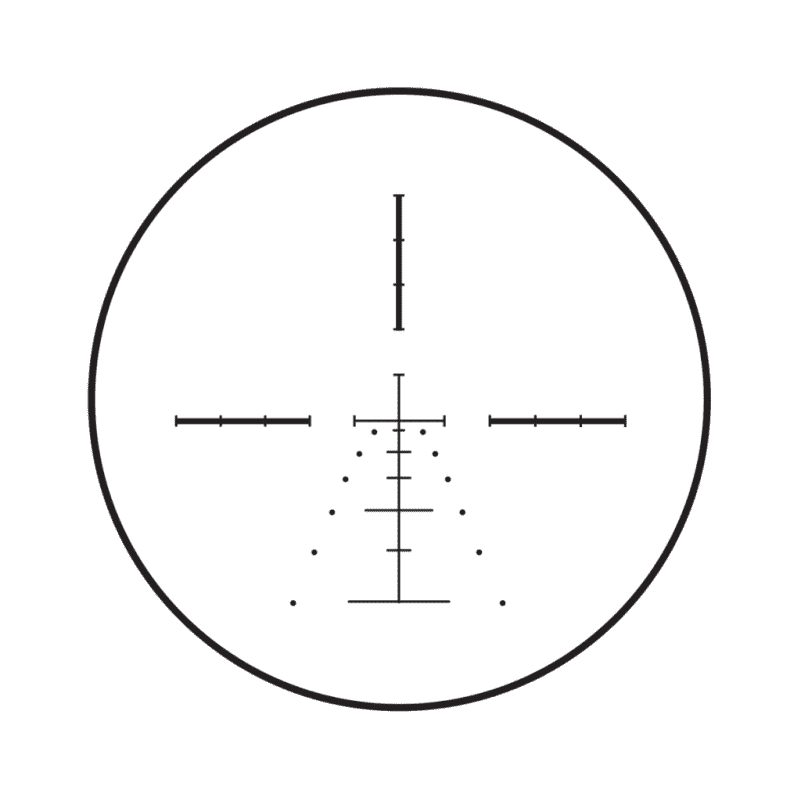
Note the “Christmas Tree” pattern on this Burris Ballistic E1 MV reticle. The dots below the crosshairs represent 10mph wind hold points at the different ranges.
For example, reticles like the Ballistic Plex E1 FFP Varmint and Ballistic Plex E1 MV have dots extending out along the horizontal axes to represent a 10mph crosswind. If you have an exact right to left or left to right crosswind, just hold the dot on the target, and you’ve compensated for the wind. If the crosswind is only 5mph, then hold half the distance to the dot. Similarly, if the wind is 20mph then hold at double the dot distance from the center.
The same concept applies to moving targets, although you might have to account for the movement of the target and the wind, so that involves a little more voodoo.
When to choose: While any scope with a dial can account for moving targets or the wind, that’s not always feasible because both moving targets and wind are… moving! If your anticipated shooting needs involve a need to adjust quickly for movement or the wind, consider a reticle with graduated marks to help you find the right hold position.
Combination Dot and Graduated Reticles
Since I sort of made up this term, let me describe the category I have in mind. Some reticles, like the Burris Ballistic AR, CQ, Circle Dot, and XTR II Ballistic designs serve dual purposes depending on your range. In the center, you’ll find something like a full or three-quarter circle that’s generally illuminated. This large, easy to see object allows you to use that section much like a red dot. The circle is easy to pick up and works well with both eyes open shooting. However, you’ll also find graduated hash marks that begin in the center of the hollow circle area and extend downward. This feature is used like a traditional ballistic drop compensation scope. As the hash marks are “measurable” you can easily figure out which mark corresponds to given ranges with your ammunition of choice. Many reticles like this are pre-calibrated for fixed 5.56x45mm ammo so the marks might correspond to 200, 300, 400, and 500 yards. You’ll even find that many of these reticles offer basic ranging capability. For example, if an object the size of a head fits just inside of the circle, then it’s 100 yards away.
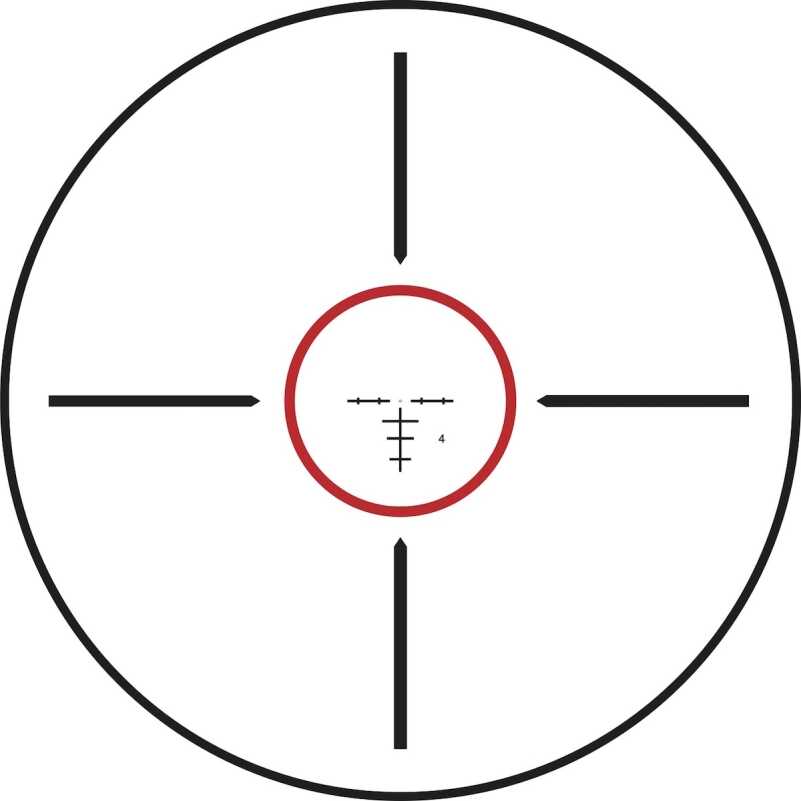
This Burris Circle Dot is a good example of a combination reticle. The illuminated ring provides fast “red dot like” sighting while the graduations provide hold point for longer range shots.
When to choose: These combination reticles are great for the AR-rifle platform. As it gains in popularity for short-range use in both competitive and defensive applications, it’s a great way to have fast sighting at close range, while still offering reasonable precision out to the effective range of the cartridge.
Summing it up
As I said in the beginning of this article, there are somewhere around 96.2 billion different reticle designs. Most of those are in the basic categories we’ve just described, but not all. For example, take a look at the Horus H591 reticle if you need quick precision at long range, and are willing to invest the time to learn your mil-dot system. That reticle is incredibly granular for both windage and elevation holdovers. Additionally, you’ll find a series of bars designed to help you quickly determine the distance to target. The idea is that without removing your eye from the target, you can figure out the range, determine elevation holdover, estimate the wind, and adjust for windage.

When you’re ready to graduate to full-fledged reticle geek, check out the Horus H591.
Another nifty innovation is the X96 reticle used on the Burris Eliminator III Laserscope. When looking at your target, press a button on the scope to activate an internal laser rangefinder. Based on the information you entered into the scope’s memory, a dot will light up at the correct elevation holdover point. It doesn’t get much easier than that.
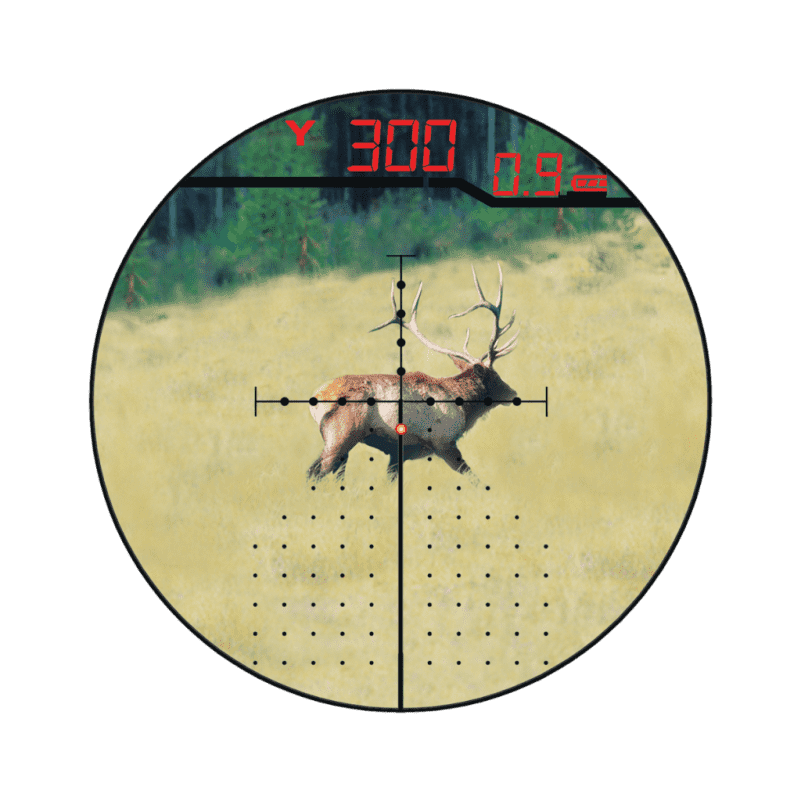
Modern technology has come to reticles. This X96 comes with the Burris Eliminator laser scope. Press a button and the internal laser rangefinder determines distance and lights up the correct holdover dot.
The easiest way to boil the ocean of reticle types is to think about what exactly you want to do with the host rifle. If you plan to move the scope around to different rifles, consider something generic like a straight duplex or mil-dot pattern. If it’s going to live on a standard caliber rifle like a .223 Remington or .308 Winchester, and you plan to use “normal” loads, then a ballistic drop compensated reticle could work well. Whatever the application, just consider that reticles are designed differently for a reason, and the better you can match the design to your intended use, the better your results on the range will be.

Dose the X 96 reticle come on any other scope, thx CR
That last one is in the $2000 range!